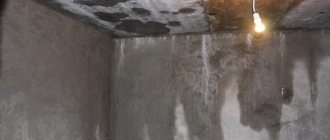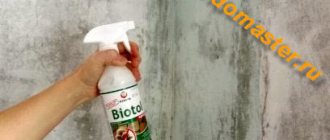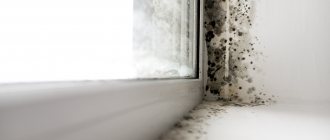Mold easily grows in any basement or cellar. The reason for this is a favorable environment: high humidity, poor ventilation system or poor quality waterproofing.
To prevent this, you need to constantly perform preventive work. If the moldy fungus has already managed to penetrate into the cellar space and is quickly spreading there, folk methods or effective modern drugs will help get rid of it.
What is mold
This substance is a fungal colony. Its spores constantly hover in the air and, when a favorable environment arises, they attach themselves to a suitable surface and begin to quickly take over space and reproduce. To do this, the fungus needs high air temperature and high humidity.
The surfaces on which mold can live are very different. The colony will successfully develop on wood, concrete, brick and other materials. It gradually takes over walls and ceilings, moves to the ceiling and other building structures. Over time, the fungus penetrates the thickness of walls and ceilings and destroys the material. Therefore, if steps are not taken in time to destroy the colony, the house will soon need to be repaired or even rebuilt.
Important! Separate black, brown and white mold. The shade of the fungus indicates class and the age of the colony. Often the color of mold is influenced by the nature of the surface where it grows.
Molds do not develop on their own. Usually there are objective prerequisites for this. The causes of mold in the cellar are:
- insufficient supply of fresh air, poor operation of the ventilation system or its clogging;
- accumulation of condensation as a result of increased moisture or lack of ventilation;
- poor circulation and air stagnation in the cellar space;
- finding rotten foods in storage, which are an excellent breeding ground for the colony;
- use of wood affected by mold as a building material.
Preventive measures
The walls will need to be dried before storing food again. It would be a good idea to whitewash the ceiling, paint all surfaces, and treat the boards for shelving. Ventilation and waterproofing must be constantly checked for damage.
Prevention should be carried out annually exclusively in the summer. In this case, the air temperature should be without sudden changes that contribute to the formation of condensation. To avoid new fungal infections, wall waterproofing is always available.
Under what circumstances does fungus grow in the cellar?
Mold does not always appear in the basement. To do this, the following conditions must be simultaneously met:
- The appearance of mold spores in the airspace of the utility room. They can be carried along with food, on human skin or animal fur.
- Presence of a nutrient organic medium. This could be paper, wood fibers, peat pots, fertile soil.
- Microclimate with high humidity and temperature at +20 degrees. Stagnant air increases the likelihood of mold growth.
Not all types of mold require air heating above +20 degrees. There are fungi that successfully reproduce even at 0 degrees.
It is also necessary to note the quality of the ventilation system. The freely circulating air flow does not allow mold spores to gain a foothold on the surface. Therefore, where the air is stagnant, mold forms more often. The movement of air masses in the corners of the room is especially difficult. Therefore, mold grows there more often.
High-quality ventilation does not allow excess moisture to accumulate in the utility room, resulting from a significant difference in temperature between outside and inside or due to increased humidity. Spores are unable to take hold and germinate, even if they are present on structures, but there are no suitable conditions for development. Therefore, the main reason for the development of mold in the cellar is considered to be poor-quality ventilation.
Microwave method
This is one of the most convenient options for destroying microorganisms. Any dampness in the cellar will be eliminated. The process does not involve the use of chemicals that can harm human health. No matter the number of mushroom colonies, they will all be destroyed, and the spores floating in the air will not be able to settle on the walls.
The principle of operation is that a wall or any surface (floor, parquet, ceiling) is heated in sections of 50 by 50 cm to a temperature of 66-73 degrees Celsius in a very short time. It takes 5-10 minutes to get rid of mycelium at a depth of 30-37 cm.
The advantages of the microwave method directly prevail over other options. All types of small organisms are destroyed; due to the heating of the room to 60 degrees, any microorganisms die. If you have to work with a large quadrature, then it warms up in sections.
Health harm from mold
Not all people know why white mold in the basement is dangerous for building structures and for health. In addition to the danger of injury due to a floor or ceiling destroyed by fungus, mold causes many diseases. Contact with spores of a fungal colony is possible directly with the skin, after inhaling particles along with air, or through eating foods contaminated with the fungus.
Most types of mold reproduce at an incredible rate. After all, just 1 square meter of a colony throws over a billion spores into space. Because of this, after penetration into the body, the fungus provokes various diseases:
- dermatological diseases that develop as a consequence of an allergic reaction;
- diseases of the upper respiratory tract, including sinusitis, nosebleeds, difficulty breathing, chronic runny nose;
- headache and dizziness;
- diseases of the digestive system;
- anemia and exhaustion of the body.
When a person is constantly in contact with mold, serious diseases develop that lead to disability. Elderly people, those weakened by illness, and children are especially sensitive to such proximity.
Important! You can detect the presence of an allergic reaction to mold by passing the appropriate tests. If the diagnosis is confirmed, measures must be taken to destroy the fungal colony.
conclusions
Answering the question why disputes often form in the underground spaces of private houses, the main thing is highlighted:
- High humidity is the main reason. This problem is solved by drying and waterproofing.
- During construction, no attention is paid to ventilation.
- Spores live in dark places.
They fight microorganisms using folk methods and specialized means. The spore elimination period takes up to two weeks. For complete removal, the room is cleaned, ventilated and waterproofed. The process of deliverance consists of a set of actions. Includes mold removal and prevention. It can be removed using chemical or folk remedies, and prevention is to keep the room ventilated and dry.
Ways to fight
To completely destroy a mold colony, you need to put in a lot of effort and spend a lot of time. Before treating the room with special preparations, it is necessary to eliminate malfunctions in the ventilation system. Adjust the temperature and humidity levels. Otherwise, despite all efforts, the mold will grow again. Only an integrated approach will help destroy the enemy. The fight against mold in the basement is carried out in several stages.
Preparing the premises
Before getting rid of fungus in a cellar or basement, the room is completely cleared of the objects located there. They take out all products, tools and equipment. This will free up the work front and open access to possible places where fungus accumulates. Removed furniture is also treated with special preparations to avoid re-infection.
The cellar room is thoroughly cleaned and all mold is removed. If building structures are deeply affected by fungus, the parts are replaced with new ones. The earthen floor in the cellar is probably already contaminated with mold spores. Therefore, 20 cm of soil is removed and replaced with new one.
The cleaned cellar room is thoroughly dried. Only after this is it treated with special preparations to completely eliminate the fungus.
Destruction of a moldy colony
Simply removing visible mold and removing fungus in the cellar is not enough for complete destruction. Fungal spores have already penetrated into building structures and surfaces. Therefore, to combat mold in the cellar, they are treated with special antifungal and disinfectant preparations. You can purchase such products at construction and hardware stores. In this case, a good result can be achieved using folk recipes against mold. They are effective and do not harm human health.
Sulfur checker
This device kills mold with sulfur dioxide vapor. The device is very easy to use and effective, so it is recommended to use it first. Before processing, all ventilation holes in the cellar are closed to block air access. The checker is then placed in a metal container and set on fire. Immediately after this, the room is left and the entrance is tightly closed. After 5-6 hours, the cellar is ventilated to remove remaining vapors. Then the floor is covered with slaked lime to remove excess moisture.
Important! Sulfur dioxide is not only harmful to mold. It affects the health of humans and domestic animals. Therefore, they must leave home during treatment.
Vinegar
This product has good cleaning ability and destroys mold spores. White undiluted vinegar is poured into a convenient container. Then dip a brush in the liquid and treat all surfaces in the basement. There is no need to wash the substance with water. 12 hours after treatment, the entrance to the basement and ventilation are opened to get rid of the smell.
Bleaching
The method of getting rid of mold using preparations containing chlorine is comparable in its effectiveness to the action of a sulfur bomb. Any product that contains high concentrations of chlorine is suitable for this method. Inexpensive chlorine bleaches, such as Belizna, are usually used. It is diluted in water, adding 10 parts of water to 1 part of the active substance. Then the liquid is applied to all the walls, ceiling and surfaces of the shelving in the cellar.
Lime
Before using lime to remove mold, the cellar is treated with Dezaktin. It is diluted with water according to the instructions and applied to walls, ceilings and other surfaces. Lime is then applied in one of the following ways:
- 0.5 kg of bleach and 0.2 kg of formaldehyde are dissolved in 10 liters of water. All surfaces in the cellar are coated with this liquid. After this, dry the room and ventilate it.
- 0.5 kg of slaked lime and 50 g of copper sulfate are diluted in 10 liters of water. A spray bottle is used to distribute this solution.
Lemon acid
Using citric acid, you can successfully fight mold in the basement of a private house. To do this, dissolve 100 grams of crystals in 10 liters of water. The resulting solution is sprayed into the cellar. After this treatment, the room is simply dried.
Copper sulfate
Sometimes treating all surfaces with copper sulfate helps remove fungus in the basement of a wooden house. To do this, prepare a solution of 30 liters of water, 250 g of copper sulfate and 2 kg of quicklime. The liquid is applied to the walls, floor and ceiling in the cellar or basement using a paint roller or brush.
Borax
You can get rid of mold in the cellar, if it has appeared there, using borax powder. To do this, prepare a solution of 3 liters of water and 200 g of borax. All surfaces in the cellar are coated with the prepared liquid. It is suitable for treating an attic, shed, garage or basement. To make the result more effective, the solution is not washed off.
Important! When treating a room with a borax solution, wear rubber gloves, as the drug corrodes the skin.
Grapefruit Seed Extract
Treatment with this substance is more of a preventative measure and helps to avoid mold infection. To prepare the solution, take 0.5 liters of water and pour in 20 drops of grapefruit seed extract. The liquid is poured into a spray bottle and all surfaces in the treated area are sprayed. There is no need to rinse off the composition.
Tea tree oil
Tea tree has antibacterial properties. Therefore, its oil ester is able to remove mold. The product is mixed with water and sprayed throughout the cellar. After a few hours, the drug will take effect and the mold spores will die. There is no need to rinse this product off.
Hydrogen peroxide
Hydrogen peroxide has good antifungal and antibacterial effects. Therefore, it is recommended to use it to clean a room of mold. You can use this tool in two ways:
- mix half and half with water and spray all surfaces in the basement;
- coat the walls, floor and ceiling, as well as shelving with undiluted peroxide.
Bleach with slaked lime
Another effective solution for removing mold is prepared from 1 liter of water, 3 tbsp. l. bleach and the same volume of slaked lime. The liquid is thoroughly mixed and applied to all surfaces in the cellar.
Boric acid
Another good way to solve the problem is to treat the cellar against mold and mildew with a solution containing boric acid. To do this, dissolve 1 kg of salt in 5 liters of warm water and add 100 g of boric acid. The ingredients are mixed until completely dissolved and sprayed throughout the room.
Using an ultraviolet lamp
Another way to remove mold in the cellar is exposure to ultraviolet rays. This treatment method will require a powerful quartz lamp or a bactericidal one. It is installed in the center of the cellar. If the infection is concentrated in one area, the lamp is directed towards this place. Then plug the device into the network and leave it for up to 12 hours.
Important! Ultraviolet rays are harmful to the eyes. Therefore, when working with a quartz lamp, they are protected with special glasses. Immediately after connecting the device to the network, they leave the room.
Cleaning the basement with a vacuum cleaner
To reduce the amount of mold and to prevent allergic diseases due to the impact of its spores, it is useful to clean the cellar room, as well as other rooms in the house, with a vacuum cleaner with a HEPA filter. The pores of such a filter are so small that they can retain not only ordinary dust, but also microscopic fungal spores. Therefore, preventive treatment with a HEPA filter helps get rid of allergens and maintain health.
Sulfur checker
The oldest, but no less effective way to destroy fungus in the cellar. Gas vapors spread throughout the entire infested area, which helps remove mold from the walls.
This method is prohibited for use in apartment buildings! May result in criminal liability as you are essentially spraying highly toxic carcinogens over a large area. Be careful!
Approach the matter with caution, guided by the following rules:
- Having a good ventilation system, you will need to tightly close the air shafts - old rags or foam rubber will do just fine. We carry out the same procedure with the basement exit.
- Then the checker is set on fire and remains inside for several hours (preferably from 8 to 12).
- After disinfection is completed, the room will need to be thoroughly dried and ventilated.
- Surfaces exposed to gas vapor will need to be treated with slaked lime.
- Before working with a saber, protect your respiratory organs, eyes, and skin. After setting it on fire, immediately leave the disinfection site. Smoke is POISON!
Precautionary measures
Since most anti-mold products are quite dangerous if handled carelessly, basement treatment is carried out using personal protective equipment. To do this, before starting work, put on rubber gloves, a respirator or mask, and safety glasses. Exposed parts of the body are protected with a special suit.
Solutions prepared for treatment should not be touched or inhaled. After the antifungal solution is applied to the walls and other surfaces, the room must be left and the entrance closed for several hours.
Important! Do not eat foods contaminated with mold. They will definitely be thrown out.
Chemicals and chlorine-containing products
This includes various detergents, bleaches and disinfectants. Therefore, if you have been diagnosed with a “fluffy infection”, immediately grab bleach or bleach.
The process is quite simple:
- Immediately after mechanical treatment with a rag or brush, a highly concentrated chlorine solution should be prepared.
- Apply it to all areas affected by fungus.
Chemicals and chlorine-containing products are extremely dangerous for the human body. Work exclusively in special clothing (gown and respirator). During disinfection, the room must remain open for ventilation.
Chlorine also prevents the appearance of fleas by burning them on the vine.
Prevention
After mold is removed from the cellar, it is important to create conditions under which re-infection of the room will be impossible. To do this, you need to maintain a certain microclimate:
- Check the quality of ventilation. If it does not work, troubleshoot. If there is no ventilation at all, it needs to be done.
- The basement is insulated and high-quality waterproofing is created from the outside. It is best to do this during the construction stage, but if desired, work can be carried out after its completion.
- They make a window that is periodically opened to let sunlight into the room.
There should be good air circulation in the cellar so that it does not stagnate. To do this, install open racks with lattice shelves. All products and things are laid out on these structures so that they do not come into contact with the walls.
It is important to monitor the humidity level. If condensation appears, the room is dried and the cause of its formation is eliminated. It is recommended to monitor temperature and humidity using a household thermometer and hygrometer.
Lime vapor
Any affected material is treated with lime. It is often used as a preventive measure against the settling of flowering spores. It can also be used in several ways: a mixture with formaldehyde or copper sulfate.
- In the first case, 200 grams of formaldehyde and 500 grams of bleach are diluted in a bucket of water. The resulting mixture is used to treat foci of infection.
- Mixing a kilogram of lime with 100 grams of copper sulfate produces slaked lime, which I use to treat the affected area with a spray bottle.
Reviews
Pavel, 45 years old
I recently discovered black mold in the corners of my basement. It turned out that condensation was accumulating on the walls. We had to urgently dry the room, and we got rid of the mold with a sulfur bomb. A very effective remedy.
Igor, 37 years old
Mold developed on the potatoes in the cellar because it was too warm. We ventilated the cellar and adjusted the ventilation. Of course, I had to throw out some of the potatoes. For prevention, all the walls were coated with bleach.
How to dry a cellar from dampness
How to dry a cellar in a garage from moisture:
- Heat gun (powerful fan heater) . Drying with a fan heater for 48 hours will solve the problem of high humidity in the basement and deprive the fungus of a breeding ground.
- Mobile dehumidifier . The operating principle of the device is the condensation of moisture inside the device and its release through the drainage into a container.
- Forced ventilation . Installing a fan in a ventilation system; below we will talk about this in more detail.
A construction hair dryer is not suitable for drying and heating the cellar due to its small contact area and low efficiency.











